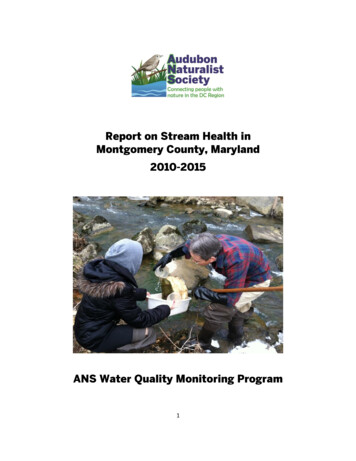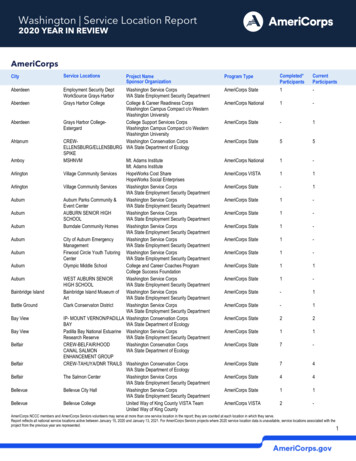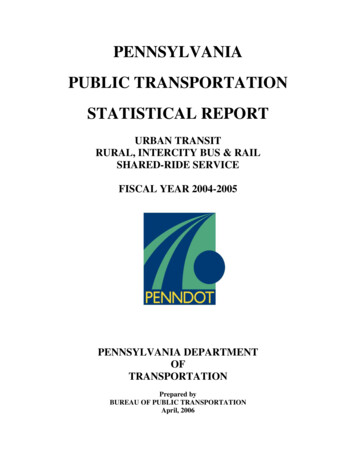
Transcription
1
The Audubon Naturalist Society is pleased to offer this report of water quality data collected byits volunteer monitors. Since the early 1990s, the Audubon Naturalist Society (ANS) hassponsored a volunteer water quality monitoring program in Montgomery County, Maryland,and Washington, DC, to increase the public’s knowledge and understanding of conditions inhealthy and degraded streams and to create a bridge of cooperation and collaboration betweencitizens and natural resource agencies concerned about water quality protection andrestoration.Every year, approximately 180-200 monitors visit permanent stream sites to collect and identifybenthic macroinvertebrates and to conduct habitat assessments. To ensure the accuracy of thedata, the Audubon Naturalist Society follows a quality assurance/quality control plan. Beforesampling, monitors are offered extensive training in macroinvertebrate identification andhabitat assessment protocols. The leader of each team must take and pass an annualcertification test in benthic macroinvertebrate identification to the taxonomic level of family.Between 2010 and 2015, ANS teams monitored 28 stream sites in ten Montgomery Countywatersheds: Paint Branch, Northwest Branch, Sligo Creek, Upper Rock Creek, Watts Branch,Muddy Branch, Great Seneca Creek, Little Seneca Creek, Little Bennett Creek, and HawlingsRiver. Most of the sites are located in Montgomery County Parks; three are on private property;and one is in Seneca Creek State Park. In each accompanying individual site report, adescription of the site is given; the macroinvertebrates found during each visit are listed; and astream health score is assigned. These stream health scores are compared to scores fromprevious years in charts showing both long-term trends and two-year moving averages. Inaddition, data collected in habitat assessment surveys is presented. This report summarizes andanalyzes the data collected during this period.Problems observed by ANS monitoring teamsIn many stream reaches monitored by the ANS teams, declining water and stream habitatquality have been observed over time. Excessive stormwater volumes and velocities undercutstream banks. This erosion causes sediment to be discharged farther downstream, and causestrees on the top of the banks to fall over, further destabilizing the channel. As described by EPA(https://www3.epa.gov/caddis/ssr urb urb2.htm), this problem is termed the Urban StreamSyndrome, in which streams “are simultaneously affected by multiple sources, resulting inmultiple, co-occurring and interacting stressors.” Two of the most prevalent stressors are loss ofurban forest lands and tree canopy, and increase in pavement levels in a given watershed.Additional urban factors and stressors observed at some sites by the ANS monitors include:sewer pipeline repair projects of the Washington Suburban Sanitary Commission; energy utility2
power line cuts; and impoundments. In several locations, stream health declines downstreamof these projects have been documented by ANS monitors, and are described in the report. Onthe positive side, streams located in rural, low-density areas and within large, forested parksshowed better than average water quality.Stream Protection and Restoration - Recommended SolutionsThe prime solution to the Urban Stream Syndrome – declining stream biological health asdocumented by ANS monitoring teams at many stream reaches in Montgomery County – is toreduce pavement and add more trees. We must protect and restore more forest acres; plantmore trees; remove pavement where possible; and wherever it can't be removed, install greenstormwater retrofits with priority given to tree- and plant-based practices. These shouldinclude: trees planted through Tree Montgomery and the RainScapes Programs; demonstrationprojects that document the volume credit that MDE should grant to trees as stormwaterpractices; riparian and upland reforestation projects; and trees planted in stormwater ponds.Giving priority to these approaches will further Montgomery's compliance with its stormwater“MS4” permit. We recommend that these tree- and native plant-based practices be appliedthrough the Treatment Train approach. In this approach, priority is given to projects located ator near the top of a drainage area, applying retrofits to sites on hilltops and hillslopes prior toinstalling floodplain and stream channel restoration projects. We also recommend reforms toupgrade the reforestation and native plant restoration protocols for utility power lines andsewer line repair projects.We urge you to share this data publicly on your website and to incorporate it into the MS4report. We also recommend using it to frame stream restoration decisions. Finally, we hope topartner with you to promote increasing tree cover as a preferred stormwater practice.3
Site visits take place during the months of April, July, October, and optionally during the winter(December – February). Since 2011, ANS monitors have followed the benthicmacroinvertebrate sampling protocol of the Maryland Biological Stream Survey (MBSS). Withina designated 75-meter reach, they use a D-net to take 20 one-foot square samples in the bestavailable habitat for macroinvertebrates. Unlike the MBSS protocol, however, ANS teamsidentify benthic macroinvertebrates to the taxonomic level of family in the field, and in somecases they have the option to identify them to genus level. After findings are recorded, most ofthe macroinvertebrates are returned to the stream. Teams are asked to preserve and send infor identification and verification any macroinvertebrates that they are unable to identify, thatcannot be identified with certainty in the field, or that are uncommon.In addition, monitoring teams conduct habitat assessment surveys and measure air and watertemperature and pH. They use the same forms as Montgomery County’s Department ofEnvironmental Protection (DEP): spring and summer habitat data sheets, based on forms fromthe MBSS, as well as DEP’s Habitat Assessment Field Data Sheet for Riffle/Run PrevalentStreams. ANS monitors fill out the latter at every site visit.Data from each monitoring visit is analyzed using the family-level benthic index of bioticintegrity (BIBI) developed for the family-level Maryland Stream Waders Program, which gives astream health score on a scale of 1 to 5.The map below shows the location of the ANS monitoring sites and indicates an average waterquality rating for the period 2011-2015. This is the time period that monitors were using theMBSS sampling protocol. Following DEP’s practice, water quality at each site has been given acolor rating of poor (red), fair (yellow), good (green), or excellent (blue). In general, streamslocated in more rural areas or within large parks with limited impervious cover show betterwater quality than those in more urbanized areas.Only two ANS sites received an excellent rating for this period: Dark Branch, located in LittleBennett Regional Park, and the mainstem of Ten Mile Creek upstream of West Old BaltimoreRoad. Two other sites rated excellent between 2013 and 2015: the unnamed tributary of TenMile Creek, on which DEP’s station LSTM204 is located, and the mainstem of Rock Creekupstream of Muncaster Mill Road. DEP calls the latter the “Fraley Farm Mainstem”, to which italso gives an “excellent” rating. Although DEP gives Dark Branch a “good” rating, it serves as areference stream for Montgomery County Parks. Ten Mile Creek serves as a reference streamfor Montgomery County DEP.4
ANS monitoring sites in Montgomery CountyEight ANS sites averaged “good” during 2011-2015. These sites are on Ten Mile Creek,Bucklodge Branch, Wildcat Branch, Hawlings River, the mainstem of Rock Creek, and the GoodHope Tributary of Paint Branch. Like the sites that rated “excellent”, these sites are located inlarge, undeveloped parks or rural areas. DEP, too, rates them “good” or “excellent”.There is less agreement on ratings for sites that ANS has found to be more impaired. ElevenANS sites averaged “fair” during the 2011-2015 period. In contrast, DEP gives a “good” rating toeight of their watersheds and a “fair” rating to only three: Dayspring Creek, the North Branch ofRock Creek at Meadowside Nature Center, and Northwest Branch at Kemp Mill Road.Some of the ANS sites that averaged “fair” did receive a “good” rating at times during thisperiod, but not consistently. This was the case for the two ANS sites on Northwest Branch atEdnor Road and Sandy Spring; the sites on North Branch of Rock Creek at Bowie Mill Road andKengla Conference Center; and on Goshen Branch. Ratings at both the North Branch at KenglaConference Center and Goshen Branch declined during this period following construction forsanitary sewers and stream restoration.5
On the other hand, the ANS site on Great Seneca Creek at Riffle Ford Road has not received ahigher rating in spring than “fair” since 1996 and frequently rated “poor”. It did receive a“good” rating in summers 2012 and 2013, perhaps because more sensitive macroinvertebratesdrifted in from upstream. The ANS site on Muddy Branch downstream of River Road, which hasconsistently rated “fair”, has not received a rating of “good” since 2003.Water quality at six of the ANS sites averaged “poor” during 2011-2015. In the case of SligoCreek, both ANS and DEP agree on this rating. Very few macroinvertebrates are found at theANS site, which is downstream of fairly dense development and bordered by Sligo CreekParkway.The other ANS sites with a “poor” rating are in watersheds that DEP rated either “fair” or“good”. Yet a “poor” rating is consistent with the extent of human disturbance in thesubwatersheds of the ANS monitoring sites. Countryside Tributary of Paint Branch, Mill Creektributary of Rock Creek, the unnamed tributary of Northwest Branch at Meadowside Drive inSilver Spring, and Fallsreach Tributary of Watts Branch are all in narrow stream valley parksdownstream of suburban development built before modern stormwater controls. Majorroadways are located in some of their watersheds. The ANS site on Gunner’s Branch, which isnow closed, was just downstream of the dam for Gunner’s Lake. The stream in this location wasperiodically scoured and eroded by discharge from the lake, leaving little good habitat formacroinvertebrates.Differences in ratings can occur on the same stream. The ANS site on Hawlings River upstreamof Zion Road rated lower than the ANS site on Hawlings River approximately ½ miledownstream, in Rachel Carson Conservation Park. Since 1998, Hawlings River upstream of ZionRoad has downcut into sandy, clayey soil, a poor substrate for benthic macroinvertebrates. Itsfloodplain is covered with invasive multiflora rose. In contrast, the substrate at the HawlingsRiver site in the conservation park is composed primarily of cobbles and boulders, a much morefavorable substrate; it is well-forested; and the team found no invasive plants. This may helpexplain the disparity between the DEP and ANS ratings. It also suggests that improvementsshould be made in the subwatersheds of the ANS sites with lower ratings to bring them in linewith DEP’s ratings for their watersheds as a whole.Montgomery County has set up Special Protection Areas (SPAs) to provide greater protection tohigh quality or unusually sensitive water resources that are threatened by land use changes.ANS has nine monitoring sites within three of the Special Protection Areas: Upper Rock CreekSPA, Upper Paint Branch SPA, and Clarksburg SPA.Although these areas have been given zoning and other protections, not all of our sites in theSPAs exhibit good water quality, and their ratings are sometimes at variance with those of DEP.6
Reasons for the differences appear to include human and natural changes to vegetated riparianbuffers; drainage from more dense imperviousness than the SPA now allows; outdated or nonexistent stormwater management facilities in older communities; and exempt sewerconstruction within the stream valley itself.1. Upper Rock Creek Special Protection Areaa. Mainstem of Rock CreekOne success story is the improving water quality ofthe Rock Creek mainstem upstream of MuncasterMill Road. The surrounding area is a natural,undisturbed valley of trees and old fields. ANS datashows improving water quality from fair in springs2005-2008, to good in springs 2009-2013, and toexcellent in springs 2014-2015. DEP also has foundthis “Fraley Farm Mainstem” to have excellent waterquality.Mainstem of Rock Creek upstream of MuncasterMill RoadThe Audubon Naturalist Society has another site on the Rock Creek mainstem at theAgricultural History Farm Park. It, too, has achieved good and excellent ratings at times, but wasonly fair in 2015. The site is bordered by a narrow strip of trees surrounded by lawn on one sideand crops on the other. Fallen riparian trees caused loss of shading in summer 2012. Then,clearing of invasive plants by park personnel in 2014 left large stretches of the banks bare ofvegetation. That same year, a beaver moved in and dammed the creek.ANS site on Rock Creek at the AgriculturalHistory Farm ParkBeaver Dam on Rock Creek at the Agricultural History Farm Park7
We recommend installing streambank protection following removal of invasive plants, so thatrunoff does not impair the banks further. In addition, the stream in this location would benefitfrom a wider riparian buffer. We recommend planting native trees and shrubs on both banks toachieve the buffer widths recommended in the County’s Environmental Guidelines.b. North Branch of Rock CreekTwo of the ANS sites in the Upper Rock Creek Special Protection Area are on the North Branchof Rock Creek. One is upstream of Bowie Mill Road in Olney, and the other is at the KenglaConference Center in Derwood.Upstream of Bowie Mill Road, the NorthBranch itself serves as the boundary of theSPA. On the SPA side of the creek are farmsand homes on large lots with an 8% limiton imperviousness. On the other is aresidential subdivision of homes on smallerlots with no imperviousness limit. Becauseonly one side of the creek is protected, itdoes not receive the full benefits of theSPA. As a result, average water quality atthe ANS site was only “fair” from 20112015, although it rated “good” in spring2015.Monitoring the North Branch of Rock Creek at Bowie Mill RoadFor the North Branch at the Kengla Conference Center, ANS monitoring data showed negativechange in water quality to “poor/fair” in 2008-2009 during construction of the ICC upstream.Water quality improved to "good" in 2010, butdeclined to “fair” in 2015 following floods andsewer reconstruction by WSSC in the floodplainthe summer year before. During floods, topsoilwas washed away, a bank with several treescollapsed, and sewer construction materialswere swept into a logjam that stretched acrossthe stream. This site appears to be highlyresponsive to construction within the watershed.It remains to be seen whether water quality herewill rebound following completion of the sewerTop soil washed away and tree roots exposed by flooding inreconstruction.2014 on the North Branch of Rock Creek at KenglaConference Center8
2. Upper Paint Branch Special Protection AreaThe Audubon Naturalist Society has two monitoring sites in the Upper Paint Branch SpecialProtection Area, one on Good Hope Tributary and the other on the Countryside Tributary to theUpper Mainstem.ANS began monitoring the Good Hope Tributary inspring 2011. The site, located in a woodedfloodplain dotted with skunk cabbage, isdownstream of the ICC. Water quality ranged from“good” in spring 2011 to “fair” in spring 2015.The Countryside Tributary of Paint Branch is asmall stream located in a narrow wooded area of aneighborhood park downstream of an olderstormwater pond. Downspouts from residencesdrain directly into the park. Briggs Chaney Roadparallels the stream, in some places is less than 50meters away.Good Hope Tributary of Paint BranchAlthough DEP gives the Upper Mainstem of Paint Branch a “good” rating, the ANS site hasconsistently rated “poor”. In the last few years ANS monitors have found very fewmacroinvertebrates, almost all tolerant to pollution. On occasion, baseflow is so low that thestream cannot be monitored. We recommend inspection of the stormwater pond to determinewhether it is still functioning properly and remediation ofoutdated stormwater controls on Briggs Chaney Road andin the subdivision.Outdated stormwater culvert from BriggsChaney Road to Countryside TributaryCountryside stormwater pond9
3. Clarksburg Special Protection Area, Ten Mile CreekANS now has three sites on Ten Mile Creek, two on private property and one in Black HillRegional Park. Water quality ranged from good to excellent at these three sites.ANS teams have monitored the unnamedtributary adjacent to West Old BaltimoreRoad since 1997. This site is downstream ofDEP’s monitoring station LSTM204. It is partlywithin a pasture and partly within a smallwooded area. In early 2011, MCDOT widenedWest Old Baltimore Road, cutting into an oldberm that separated it from the stream. InSeptember of that year, floods from TropicalStorm Lee washed away much of the rest ofthe berm. Now the stream flows over theroad when it floods, and runoff from the roadwashes into the stream during average rainevents. We recommend evaluating whetherto reconstruct the berm.Only a few stones remain from a berm that separated WestOld Baltimore Road from Ten Mile Creek until 2011In 2009, ANS started monitoring the mainstem of Ten Mile Creek upstream of the ford on WestOld Baltimore Road. This site is just below DEP’s monitoring station LSTM303B. In the last fewyears, several storms have changed the water flow around theisland in the upper part of the reach and undermined mature trees.A formerly ephemeral stream at the top of the reach has nowbecome intermittent. This change has implications for the newlyadopted Ten Mile Creek Amendment to the Clarksburg MasterPlan, which requires expanded buffers for intermittent streams. Itshould be noted for planning and zoning purposes.Two-lined salamander eggs atTen Mile CreekMonitoring the mainstem of Ten Mile Creek in Black Hill Regional Park has been a project of agroup of students from the Global Ecology Program of Poolesville High School. The site hasbeen monitored only a handful of times. Water quality has ranged from “good” to “fair”. Thestream is dynamic but no change is expected in the foreseeable future.10
Several of the streams we monitor were restored between 2010 and 2015. Restoration has hadmixed results, as can be seen in this chart. Water quality at some of the streams has stayedgenerally within the same range. At Goshen Branch, though, it has declined.Goshen Branch was restored between fall 2011 and summer 2012 under ICC CompensatoryMitigation Project SC-2. Subsequently, water quality declined from “good” in 2010 to “poor” in2013-2015. Coastal Resources, Inc., which has been monitoring Goshen Branch for the StateHighway Administration, has also found negative change in the rating for benthicmacroinvertebrates. In a paper delivered at the Maryland Water Monitoring Council’s AnnualConference on November 13, 2015, Sean Sipple of Coastal Resources also noted a change infunctional feeding groups of the benthic community from scrapers to filterers. 015 Conference/Sipple Presentation finalSean.pdf.ANS data shows this, as well. At site visits since restoration, the ANS team has also found anincrease in algae and fine sediment deposition along the entire reach. In fall 2013, a beaverbuilt a dam at the top of the reach and appeared to have cut down trees planted for therestoration. The beaver abandoned the dam by spring 2014. Trees replanted since then seem tobe surviving. We will continue to study Goshen Branch to determine the cause(s) of thenegative change and to see if water quality improves.11
Newly planted trees at Goshen BranchRestoring Goshen BranchNorthwest Branch downstream of Randolph Road was restored several years ago. ANS openedits monitoring site downstream of this earlier restoration project in 2010. Since ANS beganmonitoring, the team has found both banks to be unstable, especially the left bank (lookingdownstream). In early 2013, the left bank downstream of the ANS site did collapse and wassubsequently restored. Despite this effort, the left bank at the ANS site continues to be onlymarginally stable and may need to be restored in the future. Water quality is fair.Over the years, the banks of Northwest Branch upstream of Ednor Road in Woodlawn Park hadbecome unstable and highly eroded, with several mature trees undercut and falling. DEP, incollaboration with the Maryland-National Park and Planning Commission (M-NCPPC) and theU.S. Army Corps of Engineers, restored 2,000’ of this stream in summer and fall 2013. The bankswere stabilized; stream habitat was restored with logs, tree root balls, boulders, and riprap;wetlands were created; and grasses and trees were planted on the banks. By spring 2014, thegrasses were coming up, and sand bars had formed along each bank. Water quality had startedto improve by 2015, but was still “fair”.ANS is partnering with DEP to monitor the Fallsreach Tributary of Watts Branch for the MS4permit. ANS opened its site in 2010 to record baseline data for DEP’s Fallsreach/FallsberryRestoration Project. Our site is located downstream of two stormwater ponds and a powerlinecut. DEP did restore one of the stormwater facilities in summer 2014 and plans to restore thesecond one and the streambed between them in 2017. It is too early to tell what effectrestoration will have. Water quality remains poor, although ANS monitors did find a greaterabundance of benthic macroinvertebrates in 2015 than in most previous years.One of the goals of the project is to reestablish a riparian buffer within the restoration area.The benefits of restoration upstream may not be realized downstream unless a vegetatedcorridor is also installed in the powerline cut to connect the restored segment with the rest ofthe tributary. A riparian buffer of small trees and shrubs in the powerline cut would reduce the12
volume and velocity of runoff from the powerline cut; it would moderate water temperatures;and it would provide more favorable habitat for aquatic life. To do so would mean ceasingmowing near the stream and planting a riparian buffer of native shrubs and small trees in anarea that meets or exceeds the County's Environmental Guidelines for stream buffers. Thesame technique should be applied to the mainstem of Watts Branch, which has becomeseverely eroded. The picture below shows that it, too, lacks protective riparian vegetation.Planting native shrubs within powerline cuts has been used at the Patuxent Wildlife Refuge,leading to increased species diversity. The US Fish and Wildlife Service recommends that thistechnique be adopted throughout the nation.ANS monitoring site on Fallsreach Tributary, showing the powerline cut with Watts Branch on the left and Fallsreach Tributaryon the rightIn addition to Fallsreach Tributary of Watts Branch, ANS monitored three sites just downstreamof impoundments -- on Gunner’s Branch, Countryside Tributary of Paint Branch, and DayspringCreek. Except for Dayspring Creek, water quality at Fallsreach Tributary, Gunner’s Branch, andCountryside Tributary was poorer than DEP’s rating for each watershed as a whole. Because ourfindings at Countryside Tributary of Paint Branch and Fallsreach Tributary of Watts Branch havealready been discussed, we will focus on Gunner’s Branch and Dayspring Creek in this section.Both are tributaries of Great Seneca Creek.13
Between 1995 and 2010, the Audubon NaturalistSociety monitored Gunner’s Branch justdownstream of Gunner’s Lake and the railroadcrossing. Heavy runoff from the lake had so incisedthe stream and undercut massive trees that thesite had to be abandoned after the 2010 season.The vertical banks were as high as the monitorswere tall, and the fallen trees required climbinginto and out of the stream at several locations,Gunner’s Branch downstream of Gunner’s Lakewhich was hard for them to do. Water quality wasconsistently poor, as compared to DEP’s rating of “fair” for the entire watershed. Werecommend that this location be evaluated for streambank protection.The ANS monitoring site on Dayspring Creek isdownstream of a dry stormwater pond built in themid-1990s to serve the Seneca Crossingsubdivision, a residential community of 450 units.On occasion, the stormwater pond exceeds itscapacity during storms and causes floodingdownstream. This pond should be evaluated foran increase in storage capacity.Overflow on Dayspring Creek from Seneca CrossingStormwaterstormwater pond upstreamThe metropolitan area experienced severe weather during this period, including“Snowmaggedon” in 2010, followed by a dry summer and fall; Hurricane Irene and TropicalStorm Lee in 2011; Hurricane Sandy in 2012;and several short, but intense storms in 2013and again in late spring and summer 2014.ANS teams throughout the County notedsignificant changes to their streams as a result.Erosion from high flows can be so severe thatbanks collapse, riparian trees are undercutand fall, stream channels change, and pointbars are enlarged. Streambank erosion onmany third and fourth order streams isparticularly severe. At Watts Branch inPotomac, shown on the right, mean bankStreambank erosion at Watts Branch in Potomac14
erosion is estimated to be seven meters high. Erosion on the right bank of Muddy Branch isnow two meters high.Another striking change has been loss ofriparian trees. In addition to the treesbrought down at Gunner’s Branch by highflows from Gunner’s Lake, successivestorms between 2011 and 2014 washedout all riparian trees on Great SenecaCreek upstream of Riffle Ford Road. By fall2015, there were no longer any treeswithin 15 feet of the banks. At WattsBranch in Potomac, the largest fallen treescan be seen in satellite images. Twentymore trees are expected to fall soon atthis location.Trees felled by high runoffLoss of trees can lead to stream blockages and loss of shading. On Muddy Branch downstreamof River Road, high flows created a large blockage of multiple downed trees in summer 2014.On Rock Creek at the Agricultural History Farm Park, riparian trees that fell in summer 2012caused loss of shading for the stream. In spring 2014, downed trees and branches onCountryside Tributary of Paint Branch blocked access to the established reach to such a degreethat it could not be monitored.On the North Branch of Rock Creek atKengla Conference Center, a bankdownstream of the monitoring sitecollapsed in summer 2014.On Dark Branch, an undercut bankcollapsed after a heavy rain in 2015. A 30foot stretch of riffle was washed away.Teams at other sites reported unstablebanks, as well.Some of the collapsed or unstable banksCollapsed bank on the North Branch of Rock Creek, Derwoodhave been restored. A collapsed bank onNorthwest Branch near Kemp Mill Roadwas restored in 2013, although banks upstream of the restoration continue to be unstable. Alsoin 2013, highly unstable banks on Northwest Branch upstream of Ednor Road were regraded.15
High flows have damaged human infrastructure, as well. High flows and fast currents erodedbanks, washed out a hiking trail, and exposed drainage pipes at Great Seneca Creek upstreamof Riffle Ford Road in winter 2012. As stated above, flooding from storms in 2011 washed awaythe berm separating West Old Baltimore Road from a tributary of Ten Mile Creek.Despite higher flows following storms, many of our teams also found low base flow during dryperiods, usually in the summer and fall, but occasionally in spring. Sometimes, flow was so lowthat streams could not be monitored. This was the frequently the case at Countryside Tributaryof Paint Branch even though it is downstream of a wet stormwater pond.Low flow can even be a problem at larger 3rd and 4th order streams. A dry spell in summer andfall 2010 led to limited abundance of macroinvertebrates at the ANS monitoring site on themainstem of Ten Mile Creek, a 3rd order stream. Underlying the watershed is fractured rock.The adjacent tributary is reputed to never run dry because it is fed by springs.At Wildcat Branch, another 3rd order stream, low flows were encountered in spring and fall2012, fall 2013, summer 2014, and summer and fall 2015. During these periods, fewmacroinvertebrates were found. No reason has been given for these frequent low flows, butthey may be caused by depletion of groundwater.Farther downstream, at the ANS site on Great Seneca Creek at Riffle Ford Road, a 4th orderstream, monitors observed low baseflow during many of the same seasons, but also remarkedthat water flow at their site alternates between high and low. Variable flow on the Sandy SpringTributary of Northwest Branch has often made sampling difficult.The Washington Suburban Sanitary Commission (WSSC) is currently engaged in a six-yearsanitary sewer reconstruction project. Most sanitary sewers in Montgomery County are gravityfed and located alongside streams because they are the lowest points in the landscape. Thisincludes many of the streams that ANS monitors. ANS teams have encountered temporarysewer lines and pumping stations; heavy equipment and newly-cut construction access roads;and trees cut down near their sites.We recommend frequent inspection of sewer reconstruction sites. In summer 2014, whensewers along the North Branch of Rock Creek were being reconstructed, construction debrisand trees cut down for the construction access road were allowed to wash into the stream.16
They formed a logjam, which caused flooding during storms. Monitors also observed heavyequipment operating without mandatory silt fencing along the bank.Logjam of construction materials and tree trimmingsfrom reconstructio
certification test in benthic macroinvertebrate identification to the taxonomic level of family. Between 2010 and 2015, ANS teams monitored 28 stream sites in ten Montgomery County . urban forest lands and tree canopy, and increase in pavement levels in a given watershed. . DEP calls the latter











